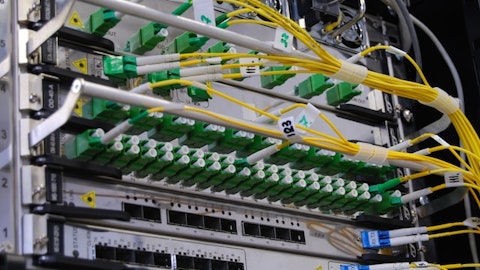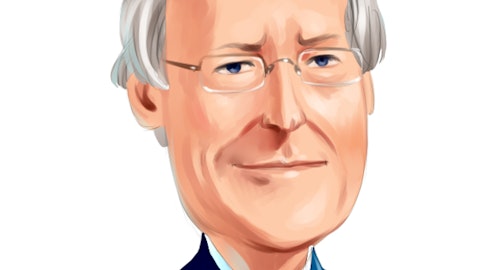Dycom Industries, Inc. (NYSE:DY) Q4 2023 Earnings Call Transcript March 1, 2023
Operator: Good day and thank you for standing by. Welcome to the Dycom Industries’ Fourth Quarter 2023 Results Conference Call. Please be advised that today’s conference is being recorded. I would like to hand the conference over to your host today, Mr. Steven Nielsen, President and Chief Executive Officer. Please go ahead, sir.
Steven Nielsen: Thank you, operator. Good morning, everyone. Thank you for attending this conference call to review our fourth quarter fiscal 2023 results. Going to Slide 2. During this call, we will be referring to a slide presentation which can be found on our website’s Investor Center main page. Relevant slides will be identified by number throughout our presentation. Today, we have on the call Drew DeFerrari, our Chief Financial Officer; and Ryan Urness, our General Counsel. Now, I will turn the call over to Ryan Urness.
Ryan Urness: Thank you, Steve. All forward-looking statements made during this conference call are provided pursuant to the Safe Harbor provisions of the Private Securities Litigation and Reform Act of 1995. Forward-looking statements include all comments reflecting expectations, assumptions or beliefs about future events or performance that do not relate solely to historical periods. These forward-looking statements are subject to risks and uncertainties which may cause actual results to differ materially from current projections, including those risks described in our annual report on Form 10-K filed March 4, 2022, together with our other filings with the U.S. Securities and Exchange Commission. Forward-looking statements are made solely as of the original broadcast date of this conference call and we assume no obligation to update any forward-looking statements. Steve?
Steven Nielsen: Thanks Ryan. Now moving to slide 4 and a review of our fourth quarter results. As we review our results, please note that in our comments today and in the accompanying slides, we referenced certain non-GAAP measures, we refer you to the quarterly report section of our website for a reconciliation of these non-GAAP measures to their corresponding GAAP measures. Now for the quarter, revenue was $917.5 million and organic increase of 20.5%. As we deploy gigabit wireline networks, wireless wireline converged networks and wireless networks, this quarter reflected an increase in demand from four of our top five customers. Gross margin was 16.5% of revenue and increased 278 basis points compared to the fourth quarter of fiscal 2022.
General and administrative expenses were 7.8% of revenue. And all of these factors produced adjusted EBITDA of $83.1 million or 9.1% of revenue, and earnings per share of $0.83 compared to $0.03 in the year ago quarter. Liquidity was strong at $757.8 million improving sequentially, and operating cash flow is $246.2 million in the fourth quarter. During the quarter, we repurchase 210,000 shares of our common stock. Now going to slide 5. Today, major industry participants are constructing or upgrading significant wireline networks across broad sections of the country. These wireline networks are generally designed to provision gigabit network feeds to individual consumers and businesses, either directly or wirelessly using 5G technologies. Industry participants have stated that their belief that a single high capacity fiber network and most cost effectively deliver services to both consumers and businesses, enabling multiple revenue streams from a single investment.
This view is increasing the appetite for fiber deployments. And we believe that the industry efforts to deploy high capacity fiber networks continues to meaningfully broaden the set of opportunities for our industry. Increasing access to high capacity telecommunications continues to be crucial to society, especially in rural America. The infrastructure investment and JOBS Act includes over $40 billion for the construction of rural communications networks in unserved and underserved areas across the country. This represents an unprecedented level of support. In addition, substantially all states have commenced programs that will provide funding for telecommunications networks, even prior to the initiation of funding under the Infrastructure Act.
We are providing program management planning, engineering and design, aerial, underground and wireless construction and fulfillment services for gigabit deployments. The services are being provided across the country in numerous geographic areas to multiple customers. These appointments include networks consisting entirely of wired network elements and converged wireless wireline multi use networks. Fiber network deployment opportunities are increasing in rural America as new industry participants respond to emerging societal initiatives. We continue to provide integrated planning, engineering and design, procurement and construction and maintenance services to several industry participants. Macroeconomic conditions, including those impacting the cost of capital may influence the execution of some industry plans.
In addition, the market for labor remains tight in many regions around the country. Automotive and equipment supply chains remain challenged particularly for the large truck chassis is required for specialty equipment. Prices for capital equipment continued to increase. It remains to be seen how long these conditions may persist. We expect demand to continue to fluctuate amongst customers but are encouraged that several have newly initiated or reiterated their commitment to programs of significant size and duration. Within this context, we remain confident that our scale and financial strength position us well to deliver valuable service to our customers. Moving to slide 6, during the quarter organic revenue increased 20.5%. Our top five customers combined produce 65.8% of revenue increasing 24.4% organically.
Demand increased from four of our top five customers. All other customers increase 13.6% organically. AT&T was our largest customer at 22.5% of total revenue, or $206.6 million. This was our eighth consecutive quarter of organic growth with AT&T. Lumen was our second largest customer, 12% of revenue or $110.3 million. Lumen grew organically 64.6% excluding operation sold right fee from the year ago period. This was our fourth consecutive quarter of organic growth with Lumen. Revenue from Comcast was $98.7 million or 10.8% of revenue. Comcast was Dycom’s third largest customer. Frontier was our fourth largest customer at $97.5 million or 10.6% of revenue. Frontier grew 152.8% organically. And finally, Verizon was our fifth largest customer at $90.5 million or 9.9% of revenue.
Verizon grew 17.6%. organically. This was our second quarter of organic growth with Verizon. This is the third consecutive quarter where our top five customers grew organically in excess of 20% and the 16th consecutive quarter where all of our other customers in aggregate excluding the top five customers have grown organically. Of note, fiber construction revenue from electric utilities was $74.9 million in the quarter and increased 30.4% year-over-year. We have extended our geographic reach and expanded our program management and network planning services. In fact, over the last several years, we believe we have meaningfully increased the long term value of our maintenance and operations business, a trend which we believe will parallel our deployment of gigabit wireline direct and wireless wireline converged networks as those deployments dramatically increase the amount of outside plant network that must be extended and maintained.
Now go into slide 7. Backlog at the end of the fourth quarter was $6.141 billion versus $6.116 billion at the end of the October 2022 quarter, an increase of $25 million. Of this backlog approximately $3.459 billion is expected to be completed in the next 12 months. Backlog activity during the fourth quarter reflects solid performance as we both work and renewed existing work. We continue to anticipate substantial future opportunities across a broad array of our customers. During the quarter, we received from Lumen, Fiber Construction agreements in Nevada, Utah, Nebraska, Iowa and Florida, for right fee, construction maintenance agreements in Kansas, Ohio, Pennsylvania, New Jersey, Virginia, Tennessee and North Carolina. From Charter, Rural Fiber Construction agreements in Missouri and Tennessee.
Various utility line located agreements in Ohio, New Jersey, Maryland and Georgia, and Various Rural Fiber Construction agreements in Washington, Nevada, Oklahoma, Missouri, Arkansas, Tennessee, Mississippi, South Carolina and Georgia. Headcount was 15,410. Now I will turn the call over to Drew for his financial review and outlook.
Andrew DeFerrari: Thanks, Steve. And good morning, everyone. Going to slide 8, contract revenues were $917.5 million and organic revenue increased 20.5%. Adjusted EBITDA was $83.1 million or 9.1% of revenue, compared to $43.3 million or 5.7% of revenue. This reflects an improvement of 337 basis points compared to Q4 €˜22. Gross margin was 16.5% of revenue compared to 13.8% in Q4 €˜22. The increase of 278 basis points reflects improved operating performance at a higher level of revenue in the current period. G&A expense of 7.8% improved 53 basis points compared to Q4 ’22 from improved operating leverage and tight management of costs. Net income was $0.83 per share, compared to $0.03 per share in Q4 last year. The increase in earnings reflects higher adjusted EBITDA, lower depreciation and amortization and higher gains on asset sales, partially offset by higher stock-based compensation, interest expense and taxes.
The effective income tax rate of 22% this quarter was slightly below our expectation. Looking ahead to Q1, we expect an effective income tax rate of approximately 26%. Going to slide 9, our financial position and balance sheet remained strong. We ended Q4 with $500 million of senior notes, $332.5 million of term loan and no revolver borrowings. Cash and equivalents were $224.2 million and liquidity was strong at $757.8 million. Our capital allocation prioritizes organic growth, followed by opportunistic share repurchases and M&A within the context of our historical range of net leverage. Going to slide 10, cash flows from operating activities were strong at $246.2 million in Q4. Capital expenditures were $62.3 million net of disposal proceeds and gross CapEx was $65.2 million.
Capital expenditure net for the full year of fiscal 2023 were $183.6 million. Looking ahead to fiscal year 2024, we expect net CapEx to range from $220 million to $230 million. During Q4, we repurchased 210,000 shares of our common stock for $20.2 million. That combined DSOs of accounts receivable and net contract assets was 108 days, a decrease of four days sequentially as we had solid collections from customers during the quarter. Going to slide 11. As we look ahead to the quarter ending April 29, 2023, we expect contract revenues to increase mid to high single digit as a percentage of contract revenues as compared to Q1 of last year. And non-GAAP adjusted EBITDA percentage of contract revenues to increase modestly compared to Q1 of last year.
We also expect $10.6 million of net interest expense, reflecting higher market interest rates compared to the prior year period and an increase in interest income. Lastly, we expect a 26% effective income tax rate and 29.8 million diluted shares. Now I will turn the call back to Steve.
Steven Nielsen: Thanks Drew. Moving to slide 12. This quarter we experienced solid activity and capitalize on our significant strengths. First and foremost, we maintain significant customer presence throughout our markets. We are encouraged by the breadth in our business. Our extensive market presence has allowed us to be at the forefront of evolving industry opportunities. Telephone companies are deploying fiber to the home to enable gigabit high speed connections. Increasingly rural electric utilities are going to stay, dramatically increased speeds for consumers are being provisioned and consumer data usage is growing particularly upstream. In fact, during the fourth quarter gigabit connections doubled to over 25% of all broadband subscribers.
Wireless construction activity in support of newly available spectrum bands continues this year. Federal and state support for rural deployments of communications network is dramatically increasing in scale and duration. Cable operators are increasing fiber deployments for rural America, capacity expansion projects are underway. Customers are consolidating supply chains, creating opportunities for market share growth and increasing the long term value of our maintenance and operations business. As our nation and industry navigate economic uncertainty, we remain encouraged that a growing number of our customers are committed to multiyear capital spending initiatives. We are competent in our strategies, the prospects for our company, the capabilities of our dedicated employees and the experience of our management team.
Now, operator, we will open the call for questions.
See also 12 High Growth Software Stocks that are Profitable and 12 High Growth Healthcare Stocks to Buy .
Q&A Session
Follow Dycom Industries Inc (NYSE:DY)
Follow Dycom Industries Inc (NYSE:DY)
Receive real-time insider trading and news alerts
Operator: Our first question comes from the line of Steven Fisher with UBS.
Steven Fisher: Thanks. Good morning. So, Steve, it sounds like you still have a positive view of the bigger picture cycle on fiber investments. Can you just maybe give us some sense of how you see the rest of the year playing out after Q1 is to what extent do you think the that range of outcomes as narrowed a bit now that your language is a bit more positive than last quarter? I’m just curious how you kind of see that the net of some customer puts and take on some of their comments.
Steven Nielsen: Sure, Steve. So there’s obviously, there’s been lots of commentary in the industry about how calendar €˜22 finished and how people are thinking about calendar €˜23. What did some research just this week that that had about 6.6 million homes completed in €˜22. An expectation of that seven and a half million homes this year. So a nice increase. And I think that’s something that we certainly see as an opportunity in the business for us to grow. I think we also are encouraged about in customer commentary on their earnings calls, or analyst days where they either initiated or reiterated commitments to programs, pretty significant size and duration. So it’s a year. Obviously, no guarantees, but we feel pretty good in this year, based on everything that we see.
Steven Fisher: Okay. And then I guess from a margin perspective, it seemed like some of the customers were maybe pulling back on the number of fiber passage just because the costs were higher. I’m curious how you see that playing out through your margins? Are you kind of passing along dollar for dollar inflation? And that’s maybe a drag on the margin percentages? Or can we expect maybe some acceleration in margins over the course of the year, as it seems like you should now be done with that challenging legacy projects? You’re getting higher scale of revenues? Just curious how you see the margin trajectory from here?
Steven Nielsen: Yes, I think, Steve with respect to kind of our customers cost to pass. I mean, there’s lots of inputs into that calculation, we’re certainly one of them. I think it at least in our experience, and this is not for any specific customer, but generally, their costs reflect the mix of types of work that they’re performing. Aerial work is obviously less expensive than buried work, work for to serve multiple dwelling units is comparable to aerial. And so from our perspective, we’re comfortable with where we are with customers. We’re having good conversations, and I don’t think we would characterize them any more than that. But we have seen fluctuation in the overall number of costs for homes passed over time. I think with respect to the margins, and we certainly will have less margin headwind.
As we’ve talked about before out of this closing out of this large customer program. We’ve had good conversations about the cost of the business right now in a period of time where labor is tight and no guarantees, but again, we feel optimistic about this year.
Operator: Our next question comes from a line of Adam Thalhimer with Thompson Davis.
Adam Thalhimer: Hey, good morning, guys. Great quarter. Hey, Steve, the unnamed customer, this is actually your best quarter from them. It was a January quarter. Is there anything lined up for this year that would cause you to expect growth there?
Steven Nielsen: Again, Adam, I just reiterate what we were talking about with Steve is that there have been a number of customers that have publicly talked about expanding their programs, either in markets that they currently serve, or are in expansion markets, and we’re pleased to participate where we can provide good, valuable service.
Adam Thalhimer: And was hoping to get some color on Brightspeed. Curious if the revenue that you reported in Q4 was kind of legacy maintenance work. And then you also had a bunch of new territories announced with them. I’m curious if they’re kind of on the path to be. I guess the question is, are they on a path to be a top five customer?






